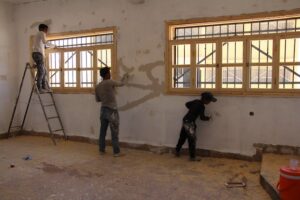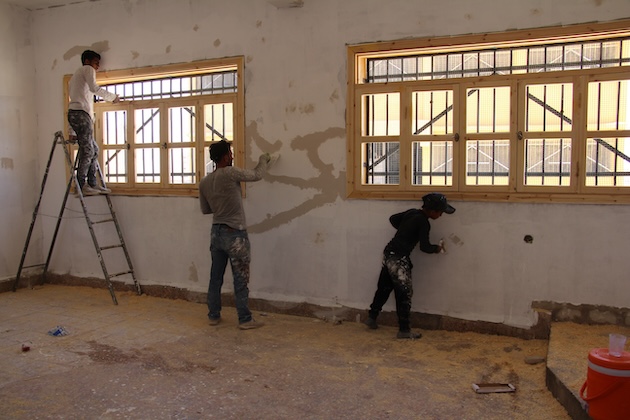
Active Citizens, Africa, Aid, Artificial Intelligence, Asia-Pacific, Civil Society, Climate Action, Climate Change, COP30, Development & Aid, Editors’ Choice, Featured, Food and Agriculture, Food Systems, Global, Headlines, Humanitarian Emergencies, Latin America & the Caribbean, TerraViva United Nations, Trade & Investment

If we do not have our land and healthy territory, we do not have healthy food, and without food we do not survive. Food must become a centerpiece in the global climate discourse, and it is not just about any food, but healthy food that aligns with our ancestry and local traditions and spirituality. —Juliana Kerexu Mirim Mariano, activist

Juliana Kerexu Mirim Mariano, coordinator for the Guarani Yvyrupa Commission that advocates for the rights of Guarani peoples in southern and southeastern Brazil. Credit: Joyce Chimbi/IPS
– A young woman at COP30 speaks about retracing her father’s footsteps. At only 16, her father and her grandfather were among the first families displaced by an unfolding climatic crisis of erratic weather and worsening climate conditions that goes on to date from their ancestral village in Sundarbans. Nearly 60 years later, she is on a mission to reclaim her ancestral lands.
The Sundarbans is the world’s largest mangrove forest, located on the delta of the Ganges, Brahmaputra, and Meghna rivers in the Bay of Bengal, straddling the border of India and Bangladesh.
This complex ecosystem is a vital habitat for the Royal Bengal tiger and other wildlife, while also providing critical ecosystem services like storm protection and livelihoods for millions of people. It is a UNESCO World Heritage Site and faces threats from climate change, rising sea levels, and human activities.
She said farming activities in the Sundarbans have been severely disrupted and degraded by environmental changes, primarily increased soil and water salinity, more frequent and intense cyclones, and sea-level rise. These factors have led to a decline in crop productivity, changes in traditional farming patterns, and a shift in livelihoods towards aquaculture and migration.
But the Sundarbans do not stand alone. From across the global South, delegates are speaking about their shared tragedies of weather patterns out of joint with their farming systems.
Juliana Kerexu Mirim Mariano, the coordinator of the Guarani Yvyrupa Commission, told IPS her organization advocates “for the rights of Guarani peoples in southern and southeastern Brazil, particularly the recovery of their ancestral lands in the Atlantic Forest.

The Belém Declaration on Hunger, Poverty, and Human-Centered Climate Action, launched during the COP30 Leaders Summit, places the world’s most vulnerable populations at the center of global climate policy. Credit: Joyce Chimbi/IPS
“Its mission is to organize a political struggle for land demarcation, which is vital for preserving cultural traditions and way of life. The commission works to secure land rights, and its efforts align with the preservation of the Atlantic Forest biome, as the Guarani have lived in the region for centuries and their culture is deeply connected to its biodiversity.”
“Within our territories, we do annual plantations for us to continue producing our sacred food, preserving our traditional ceremonies, which are linked to us and to spirituality. Our spirituality is directly connected to our food, to our plantations, to our land,” she explained.
“But all these are now under threat. We have seen this abrupt change and emergencies caused by climatic changes. So, for example, in our village, we have not been able to harvest food for more than three years.
“We have only managed to keep our sacred seeds because either it rains too much or it rains too little—at the time of the annual plantations, we have only managed to maintain the part of the traditional ceremonies that is spiritual.”
Njagga Touray, Party representative from the Gambia in West Africa, told IPS that “the food situation in the country, just like many others, is not very promising. Climate change leads to land degradation due to increasingly erratic rainfall, which decreases our production; we need to feed a growing population and plan for the next generation.”
The COP30 agenda is alive in this dire situation. The Belém Declaration on Hunger, Poverty, and Human-Centered Climate Action, announced and endorsed by 44 countries last week, launched a new Climate-Resilient Social Protection and Smallholder Agriculture Finance Partnership.
Delegates say this progress has instilled a renewed sense of optimism—proving that elevating adaptation and unleashing technology within the world’s farming systems helps the global community to redefine resilience, transforming vulnerability into strength and ambition into action.
Recognizing the fundamental role of combating hunger and poverty for climate justice, a new Climate-Resilient Social Protection and Smallholder Agriculture Finance Partnership has already been launched under the COP30 Action Agenda.
This partnership supports the Plan to Accelerate Solutions (PAS) by setting clear goals to encourage action and monitor progress, which includes helping countries like Benin, Ethiopia, Kenya, Zambia, and the Dominican Republic create plans for social protection, support small farms, and improve access to water.
The PAS brings countries together with international partners and subnational networks to align national ambition with local action, integrate local priorities into NDCs, and institutionalize multilevel governance as a foundation for achieving the Paris Agreement’s goals.
By 2028, the plan is expected to have established a joint coordination group of climate finance donors to align portfolios in support of efforts to combat hunger and poverty. Importantly, the launch builds on the November 7, 2025 adoption of the Belém Declaration on Hunger, Poverty, and Human-Centered Climate Action by 44 countries, a landmark commitment developed with the Global Alliance Against Hunger and Poverty during the COP30 Leaders Summit held just days before the start of the UN climate conference.
Furthermore, two innovative digital tools have also been launched to support climate-smart agriculture at scale. Brazil and the UAE, in partnership with the Gates Foundation, Google, and leading global agricultural institutions, announced the world’s first open-source AI Large Language Model (LLM) for agriculture, a breakthrough toward a more resilient and equitable global food system.
Secondly, the AIM for Scale, a farmer-centered AI forecasting tool, could empower over 100 million farmers by 2028 by providing real-time insights that strengthen climate-smart decision-making, risk preparedness, and inclusive innovation across agricultural systems worldwide.
The Agricultural Innovation Showcase high-level event will serve as a media and political platform for governments and philanthropic leaders to announce a multi-billion-dollar package of support to fund agricultural innovations that help farmers in lower-income regions adapt to the impacts of climate change and build resilience. Nearly USD 2.8bn has been announced for farmer adaptation and resilience to strengthen global food systems.
International donors have also announced over USD 2.8bn for farmer adaptation and resilience to strengthen global food systems. In support of the COP30 Brazil Presidency’s call to make COP30 the COP of implementation, the commitments are aimed at increasing support for smallholder farmers in poorer regions who are bearing the brunt of worsening weather extremes. The donor funds will be invested in technologies and tools to help farmers adapt, build resilience, and strengthen local food systems that feed and employ billions of people.
“Agricultural innovation is the engine of climate resilience,” Martin van Nieuwkoop, Director of Agricultural Development, Gates Foundation.
Back to those on the frontlines of climate change, where it intersects with food systems, ancestry, and traditions, like those of Mirim Mariano—it is a race against time.
“If we do not have our land and healthy territory, we do not have healthy food, and without food we do not survive. Food must become a centerpiece in the global climate discourse, and it is not just about any food, but healthy food that aligns with our ancestry and local traditions and spirituality.”
This feature is published with the support of Open Society Foundations.
IPS UN Bureau Report













